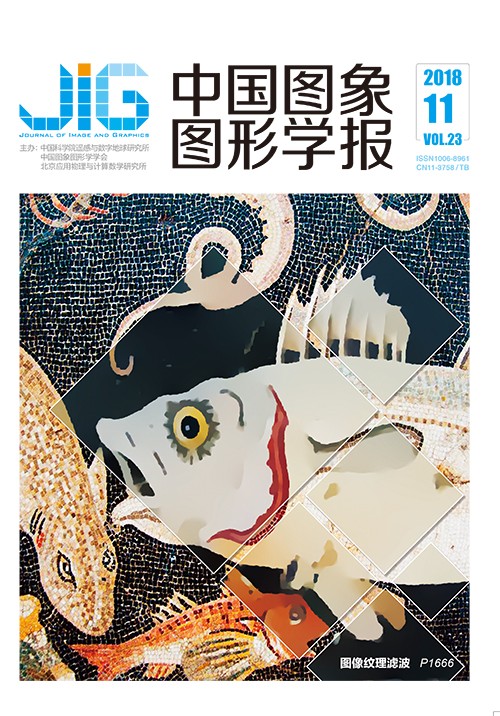
结合纹理梯度抑制与L0梯度最小化的纹理滤波
摘 要
目的 纹理滤波是计算机视觉领域的一个基础应用工具,其目标是抑制图像中不必要的纹理细节和保持图像的主要结构。目前已有的纹理滤波方法多存在强梯度纹理无法被抑制或结构丢失的问题,为此提出一种结合纹理梯度抑制与L0梯度最小化的纹理滤波算法。方法 首先,提出一种能够区分结构/纹理像素的方向性区间梯度算子,其中采取了局部对比度拉伸和尺度自适应策略,提升了弱梯度结构像素的识别能力。随后,利用区间梯度幅值对原始图像梯度进行抑制,并用抑制后的图像梯度进行图像重建,获得纹理像素梯度小于结构像素梯度的纹理抑制图像。最后,考虑到纹理梯度抑制时会对结构像素的梯度产生一定的衰减作用,本文采用具有梯度提升作用的L0梯度最小化方法对纹理抑制图像进行滤波,得到纹理抑制结构保持的纹理滤波图像。结果 通过测试马赛克和自然风景等不同类型的图片,并与L0梯度最小化、滚动引导图像滤波、相对总变分、共现滤波等方法相比较,本文算法能够在抑制强梯度纹理的情况下对图像的主要结构得以保持,并且具有良好的普适性和鲁棒性。同时本文将纹理滤波应用于图像的边缘检测和细节增强,取得了不错的效果提升。结论 本文算法在兼顾强梯度纹理的抑制和结构的保持方面已超越已有的方法,对于图像的目标识别、图像融合、边缘检测等易受强梯度纹理干扰的技术领域,具有较大的应用潜力。
关键词
Texture filtering by using texture gradient suppression and L0 gradient minimization
Shao Huan, Liu Chunxiao(School of Computer Science & Information Engineering, Zhejiang Gongshang University, Hangzhou 310018, China) Abstract
Objective Texture is a repetitive pattern with high pixel values. Many natural images and works of art include textures such as cross-stitch and mosaic. In many cases, the visual system of individuals ignores the texture pattern and focuses on the main structure of an image. Texture filtering is a basic tool in the computer graphics and image processing fields; the goal of which is to suppress unnecessary texture details and maintain the salient structure in the image. In recent years, various texture filtering methods, which are mainly divided into global-and local-based filtering methods, have been proposed. Most of the existing texture filtering methods handle the small gradient texture images. However, handling the strong gradient texture and losing part of the structure is difficult. To solve this problem, we propose a texture filtering method by using texture gradient suppression and L0 gradient minimization to suppress texture and maintain the structure. Method The main idea of this algorithm is to obtain an input image with strong gradient texture suppression and then attain the smooth filtering results through the traditional texture filtering method, which uses L0 gradient minimization. Our method involves three steps to achieve the goal of image filtering. First, we improve the interval gradient operator, which has the capability to distinguish texture and structure pixels. We propose a directional interval gradient operator to increase the gradient amplitude by finding the main direction of the structure. We use a local contrast stretching strategy when calculating the direction interval gradient to improve the recognition capability of the weak gradient structure because the pixel gradient value of the weak structure area becomes smaller than the gradient value of the strong gradient texture. The directional interval gradient affects the texture suppression; thus, selecting a computational scale is particularly important. A scale adaptive strategy, which automatically selects the optimal scale for calculating interval gradient, is proposed. Second, we aim to obtain an input image with texture gradient suppression. In the first step, we obtain the directional interval gradient value, where the structured pixel is larger than the texture pixel. Then, a normalized directional interval gradient amplitude is used as the basis for attenuating the gradient of the original image. Image reconstruction is performed after image gradient suppression to obtain a texture-suppressed image with a gray pixel gradient that is smaller than the structural pixel gradient. In the image reconstruction step, we transform the reconstruction problem into the function optimization problem, and the fast Fourier transform is applied to the frequency domain to solve the problem. Finally, we use the L0 gradient minimization algorithm with gradient lifting effect to filter the reconstructed image to remove the texture while preserving the structure because the texture gradient suppression operation causes a certain attenuation of the gradient of the structural pixels and thus results in the loss of the structure. Result We tested different types of pictures, including mosaics, nature, and grasslands, to prove the validity of the proposed method. The experiments are run on the windows platform, and the algorithm is implemented in MATLAB. Three main parameters are set, including the scale of calculating the directional interval gradient, the gradient weight η in the image reconstruction step, and the smooth parameter λin the L0 gradient minimization. η controls the suppression degree of the strong gradient texture in the reconstructed image. The texture is suppressed better with the increase in η. We compare this algorithm against other texture filtering methods, including L0 gradient minimization, rolling guidance filtering, interval gradient, co-occurrence filter, and relative total variation method. All methods use the code provided by the author and debug the optimal parameters to obtain the filter result. The field of texture filtering has no reasonable objective evaluation index. Therefore, the subjective evaluation of human eyes is used to compare the effects of different methods. The experimental results can be summarized as follows. In the mosaic image with strong gradient texture information and intractable tiny structures, this algorithm surpasses the effects of other algorithms in a strong gradient texture suppression, and the small gradient structure is also maintained. Our algorithm demonstrates superior image smoothing results in filtering out various scale textures and preserving small gradient structures when processing natural images. Moreover, texture filtering is applied to an image edge detection and detail enhancement, which achieves a favorable effect. Conclusion A texture filtering algorithm that combines texture gradient suppression and L0 gradient minimization is proposed as a trade-off between strong gradient texture suppression and structure preservation in current texture filtering methods. This paper main purpose is to suppress the texture gradient of the input image. Thus, the texture and structure pixels obtain different texture filtering operations. The experiments demonstrate that our algorithm can maintain the main structure of the image and achieve smooth gradients. In the field of image recognition, image fusion, and edge detection that are susceptible to strong gradient textures, texture filtering has a significant potential for application.
Keywords
texture filtering L0 gradient minimization strong gradient texture structure preserving texture suppression
|



 中国图象图形学报 │ 京ICP备05080539号-4 │ 本系统由
中国图象图形学报 │ 京ICP备05080539号-4 │ 本系统由